|
|
| Louis
XIV said that he needed a larger hunting lodge, wrecked the French
economy, and came up with Versailles.
Nelson
Rockefeller says that the state needs more office space, spends
a billion dollars, and comes up with a Dali-esque nightmare in
Albany. All it needs is limp watches to show that the time for
the architecture of power and vanity is past.
The
Sun King's reckless extravagance gave the world a new notion of
splendor and inspired urban planning in the grand manner-the City
Beautiful.
The
governor's reckless extravagance is an ugly anachronism-the City
Beautiful last erection.
Rockefeller's
latest and most colossal architectural production, scheduled to
open in 1973, is now irretrievably going up under the working title "The
South "I am proud of the Mall," says the governor; who keeps a blue hard hat; emblazoned with the Seal of the State of New York, in the back, of his limousine. "We are bringing back a monumental quality to the architecture of government buildings." It delights the governor to prance and climb all over the construction site, joke with the workers, and play with the big cranes. Psychiatrist Jules H. Masserman says that one of man's "Ur-defenses," most prevalent among rulers, is the delusion "that their 'name'-and therefore themselves-will be immortalized ... in their preserved bodies or in their indestructible granite monuments." Mussolini's now all-but-forgotten "Foro Mussolini" and General Franco's hideous "Valley of the Fallen" are recent examples. "The governor wanted something grand and monumental," said Wallace K. Harrison, Rockefeller's architect du roi, who designed the Mall. An architect of distinction, whose brother-in-law is married to Nelson Rockefeller's sister, Abby, Harrison has also designed three, exceedingly handsome private vacation retreats for Rockefeller, as well as many of his public works. The governor once said: "I always wanted to be an architect." When I asked him what had interfered, he answered: "It just did not seem justified." Then, after a pause: "No one would have believed I could really do it, what with all that money." The money did, however, give young Nelson a chance to play with blocks. He helped his father build Rockefeller Center, which he also managed for a while (and which gave Harrison his start in architecture). He also helped his father with the restoration of Colonial Williamsburg and the Cloisters Museum. He agreed up to be the most prolific master builder in history. The world owes him the Union Nations headquarters, Lincoln Center, the hideous World Trade Center, and the controversial State Office Building in Harlem. The governor also set up the Mental Hygiene and State University Construction Funds. Seventeen new campuses are under construction.
Trust Rockefeller, who is just about the only high government official in this country to appreciate and promote modern art-any art-to assure high artistic standards. He set up a committee with people like Rene d'Harnoncourt on it to spend 1 per cent of the Mall's construction cost on its artistic embellishment. Rockefeller himself plans to donate only a Jackson Pollack. The 1 per cent is no trifle. What began, in Stale Controller Arthur Levitt's words, as an innocent-looking "first instance appropriation" of $150 million in 1965; was originally estimated to cost $480 million, then estimated to $610 million, and has now officially reached $750 million. Levitt says the true figure will add up to a billion or more if financing charges are included. The governor said Levitt, a Democrat, is playing politics. The real trouble, the governor said, is inflation. He also admits to poor planning, estimating and coordination. The platform for the Mall, the largest construction contract in the history of New York State, drew only a single bid, and that bidder could not deliver. There was endless trouble with it as, with the governor rushing, rushing, rushing the job, some 70 prime contractors and 270 sub-contractors, trying to build a dozen buildings on the site all at once, kept climbing all over each other. Some of them are now suing or being sued by the state. "Besides," said the governor, "the thing kept sinking into the mud. It is still sinking."
In the trade, the name for these symptoms is "the Albany Factor." Because the Mall has created such great demands on labor and materials, all building in the Albany area now automatically costs 15 per cent more than elsewhere in the state. The cost of building the Albany campus of the State University, in fact, increased 50 per cent as a result. There have been economies, however. Below the Mall, along the big swath of highway that leads into the platform, was to be a low-income housing project for some 500-later only 442-families. This was to fulfill Lieutenant Governor Malcolm Wilson's pledge that the Mall plan would specifically provide new housing for the people it would displace. The initial estimate for this housing project was a little over $10 million, according to Levitt. But then the design was changed to harmonize with the splendor of the Mall. Add the “Albany Factor” and the cost doubled. The project was cancelled. “It just got way out of line,” said the governor. Under the monument are buried the homes of what his man in charge, General Cortlandt Van Rensselaer Schuyler, commissioner of the State Office of General Services, says were 3,700 people (others have said 9,000 people), most of them black and poor. Where did they go? "There was a high vacancy rate," said the general. "I may not even be re-elected," said the governor. "I wanted to be President, you know, but could not get the nomination. But this thing is going forward. Albany will be a great, a magnificent, capital." It would have a long way to go, even if it were headed in the right direction. Albany has been New York's capital since 1797 and remnants of its more charming days are still visible. But it is now as miserable and shamefully dilapidated a town as any in American civilization. Legend has it that the governor was so embarrassed about the place when Princess Liliane de Rbthy (the second, commoner wife of King Leopold III of Belgium) visited him there in February, 1963, that he resolved on its magnification.
It made sense to build new state offices downtown. Governor Dewey had started a State Office Building campus next to the State University, some three miles out. Predictably, this hastened the exodus from the city. A whole mess of stores, eateries and new apartments which should be bringing revenues and respectability to Albany are now squatting about Dewey's tinny towers out there among the freeways. The planners of the grand renewal, a team led by Archibald C. Rogers and George E. Kostritsky, had proposed four downtown alternatives for the state offices: scattered throughout the business center, along the waterfront, on a “north platform” across a ravine, or on a South Mall next to the Capital. The Mall idea had the most monumental potentials, and Rockefeller immediately seized it because it brought the Governor’s Mansion into the grand complex, much as the Mall in Washington, D.C., includes the White House along with the Capitol and the big monuments. The City of Albany opposed the scheme. It filed suit to stop Rockefeller. Mayor Erastus Corning said: "Do not build this magnificent monument on a foundation of human misery." That was in 1962. That was also when Lieutenant Governor Wilson promised the housing project whose cost later got "way out of line." Two years of bargaining began. In the end, all concerned came to realize that the magnificent monument could stand quite profitably on the foundation of misery, after all. In an incredibly complicated deal, which Levitt calls "beyond the control or even comprehension of the electorate," the County of Albany floats the bonds to build the complex which it then leases to the state for enough to pay off the bonds by the year 2004. The project employs about 2,000 workers and could be a good opportunity to provide jobs for a fair number of blacks and Puerto Ricans. But Albany's Urban League director, Lawrence Burwell, charges that the state government is working hand in hand with the building trade unions to keep them out. Adam Walinsky, a legislative assistant to Bobby Kennedy who is now aiming for the Democratic nomination as state attorney general, makes the same charge in a 66-page study he conducted with the help of five law students. Walinsky told a press conference in Albany's, DeWitt Clinton Hotel last November, "State legislators and other confidential sources have stated to us that the Mall project is being built by Canadian labor."
General Schuyler told me early in March: "There are 8 to 10 per cent colored on the job and that is a higher percentage of colored than live in this area." He kept saying "colored." He also said he did not think there were ever more than "some" Canadians on the site, 12 at present. None of this, however, has as yet raked anything like the public furor that accompanied the construction of the Slate Capitol in Albany a century ago. The outrage then was not only about state finance and propriety but also architectural style and good taste. The Legislature, in 1868, had ordered something in Roman Renaissance for around $4 million. In 1875 it found that the building, not yet half finished, was alleged to be structurally deficient, and had already cost $5 million. It thereupon fired the architect, Thomas Fuller, and gave the job to Leopold Eidlitz and H. H. Richardson, the greatest architect in America at the time. Those were the days before teamwork and group-think, and the two divided the work. Richardson took charge of the south side, which contains his opulent Senate Chamber, and Eidlitz designed the north facade with the Assembly Chamber behind it. Together they not only disdained the ever-expanding budget, but also proceeded without warning to complete the Capitol in Romanesque, which Richardson thought somehow more lusty and American. The ensuing battle of the styles raged in newspapers, salons, and saloons all over the state. By the time he got to the roof, however, Richardson was forced to give in. The Capitol of New York is probably the only building in the world with a Roman Renaissance bottom, a Richardson Romanesque middle and a "free classic" gabled top. But it's a beauty. Wallace K. Harrison (working with George Dudley and Henry Blatner) suffered no such public interference. His grand plan, like that of L'Enfant and Daniel Burnham for Washington, looks to the Roman Renaissance and the Sun King for inspiration. In fact he got rather high on it, what with running that enormous Mall perpendicular to the Capitol across a 70-foot-deep valley.
Harrison says the town will eventually live up to his Mall, which, he hopes, will set an example for the rest of his country. "Remember Vicenza," he told me. Vicenza, in northeast Italy, may indeed not have had more distinction than Albany has now before the great Renaissance architect Andrea Palladio, in gratitude for having been born there, endowed the place with some of his finest buildings. But a Palladio, Wally Harrison is not. He was trained at the Ecole des Beaux Arts in Paris, the school that, through the turn of this century, kept the grand manner alive. All his life he has, at times with much creative plan, attempted to reconcile City Beautiful. planning with International Style architecture. In those terms his Vicenza-on-the-Hudson might, just might, have given us, if not a Palladian renaissance, at least some genuine grandeur. The possibility impressed some when the scheme was first published. At a time of timid and mediocre cost-benefit architecture, there was a welcome boldness in the mega-structure that would span a valley, admit automobiles by the freeway load and sprout an instant skyline, and a neatly and classically ordered skyline at that. But the architects botched it. They turned their notion of grandeur into a caricature of that notion. And no wonder. Monumental spaces with endless imperial vistas, reflecting pool mirrors and triumphant fountains, once filling us with awe of absolute power, have become vacuous in our time. Even as 'World's Fair spectaculars they don't impress any more as they did when Wallace Harrison gave us the Trylon and Perisphere - remember? - out at Flushing Meadows back in 1939.
There are three of these monsters. Two of them, the Justice and Legislative Office Buildings, woefully crowd H. H. Richardson's rich facade and try their best to clobber it. The third, the Motor Vehicles Department, runs an unrelieved quarter mile or so along the west side of the Mall - a Berlin Wall done in marble. It bridges a highway that is to run out to the Thruway, take eight more city blocks and heaven knows how many more homes, and then tunnel under the lovely Washington Park. For the time being at least, an outraged citizenry has stopped it. But it is too late to stop the Mall and let Nelson Rockefeller enshrine his Urdefenses elsewhere. We are stuck with surrealistic grandeur. This is not to say that all the governor should have built in Albany are more humdrum office buildings. The Rogers-Kostritsky report did say, in fact, perhaps too optimistically, that "we can, after considering the state of our society and our civilization, discover the appropriate form for symbolizing an expression of a contemporary capital."
These hopes are for a new humanism in our lives and in our architecture (or "man-made environment," as the more fashionable phrase has it). The state office buildings - so placed and designed as to help revive the joys and charm of the old Albany townscape and to reconcile it with the demands of modern life – might have made a beginning. The Rockefeller family gave generously to preserve the true grandeur of the past. It restored Colonial Williamsburg, the Agora at Athens and the great halls in the Palace of Versailles. Too bad Nelson Rockefeller felt he had to build from there. Originally appeared in New York Magazine, 1976. Back
to Empire State Plaza |

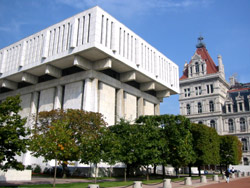 Mall of Albany, New York." It will be an elevated via
triumphalis, built on a 100-acre platform that houses cars,
convention halls and such. It will dam the valley between the venerable
State Capitol and the Governor's Mansion, and will support a dozen
huge, marble-clad buildings, including the tallest skyscraper in
the state outside New York City. In a reversal of Mies van der
Rohe's famous dictum, these buildings attempt to be original rather
than good. They have grotesque, "modernistic" (as distinguished
from modern) shapes; painfully reminiscent of one of the worst
of the century’s cultural disasters, Robert Moses’ 1964/1965
World’s Fair."
Mall of Albany, New York." It will be an elevated via
triumphalis, built on a 100-acre platform that houses cars,
convention halls and such. It will dam the valley between the venerable
State Capitol and the Governor's Mansion, and will support a dozen
huge, marble-clad buildings, including the tallest skyscraper in
the state outside New York City. In a reversal of Mies van der
Rohe's famous dictum, these buildings attempt to be original rather
than good. They have grotesque, "modernistic" (as distinguished
from modern) shapes; painfully reminiscent of one of the worst
of the century’s cultural disasters, Robert Moses’ 1964/1965
World’s Fair."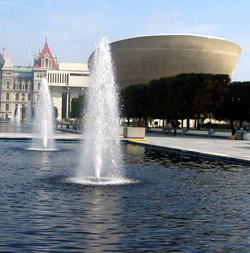 But
in a recent audience
he granted me aboard his private plane, jetting from New York to
Albany, it became clear that the South Mall has
a special place in his heart. He had just come from a state visit
to Harlem, where he had helped Duke Ellington dedicate a church
("All the things a politician has to go through," he
said by way of greeting me) and it obviously buoyed him to talk
about "the most exciting project of its kind." He was
most enthusiastic about the Mall's proposed Cultural Center.
When I reminded him that his aides in Albany now refer to this
$72-million
building as a "library and science museum," presumably
because this sounds less frivolous, he threw up his eyes in mock
despair and went right on talking about "the pools of water,
the gardens, the sculpture, y'know, feller."
But
in a recent audience
he granted me aboard his private plane, jetting from New York to
Albany, it became clear that the South Mall has
a special place in his heart. He had just come from a state visit
to Harlem, where he had helped Duke Ellington dedicate a church
("All the things a politician has to go through," he
said by way of greeting me) and it obviously buoyed him to talk
about "the most exciting project of its kind." He was
most enthusiastic about the Mall's proposed Cultural Center.
When I reminded him that his aides in Albany now refer to this
$72-million
building as a "library and science museum," presumably
because this sounds less frivolous, he threw up his eyes in mock
despair and went right on talking about "the pools of water,
the gardens, the sculpture, y'know, feller." "The
fact is," said the controller, "that the state has compressed
this building program into too short a period of time during an
inflationary era. Added to all the other construction programs,
it has intensified the pattern of over-spending and over-borrowing.
The symptoms of the disease are now upon us: unreliable estimates,
lack of normal competition, escalation in cost, rising interest
costs, and a heavy financial burden which will grow with each year."
"The
fact is," said the controller, "that the state has compressed
this building program into too short a period of time during an
inflationary era. Added to all the other construction programs,
it has intensified the pattern of over-spending and over-borrowing.
The symptoms of the disease are now upon us: unreliable estimates,
lack of normal competition, escalation in cost, rising interest
costs, and a heavy financial burden which will grow with each year." Actually,
the Mall project had already been proposed at the time, but as
part of an ambitious
urban-renewal project, not to impress minor
royalty. There were to be 7,000 new housing units, a rebuilt central
business district, a new convention hall, a federal building, a rebuilt
waterfront with fine esplanades, and lots of highway spaghetti. The
new state office buildings were to be only a part of these goodies.
But except for' the Mall and the highways, for which, along with
missiles, there is always ample public money, the vision quickly
evaporated.
Actually,
the Mall project had already been proposed at the time, but as
part of an ambitious
urban-renewal project, not to impress minor
royalty. There were to be 7,000 new housing units, a rebuilt central
business district, a new convention hall, a federal building, a rebuilt
waterfront with fine esplanades, and lots of highway spaghetti. The
new state office buildings were to be only a part of these goodies.
But except for' the Mall and the highways, for which, along with
missiles, there is always ample public money, the vision quickly
evaporated.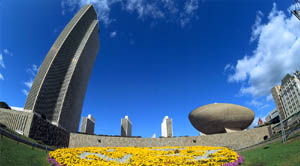 Employing
white outsiders rather than putting black New Yorkers to work,
Walinsky estimated, is costing the state about $250
million a
year in welfare. He cited no precise figures of Canadians or other
out-of-state workers on state construction jobs because-contrary
to law, he says-no such figures are kept. But one day last September,
his helpers did count black noses among the construction workers
on
the Mall. "Despite claims of state officials that as much as
25 per cent of the work force was black, we found that only 153 of
the
1,776 workmen on the project were black – 8.7 percent,” they
reported.
Employing
white outsiders rather than putting black New Yorkers to work,
Walinsky estimated, is costing the state about $250
million a
year in welfare. He cited no precise figures of Canadians or other
out-of-state workers on state construction jobs because-contrary
to law, he says-no such figures are kept. But one day last September,
his helpers did count black noses among the construction workers
on
the Mall. "Despite claims of state officials that as much as
25 per cent of the work force was black, we found that only 153 of
the
1,776 workmen on the project were black – 8.7 percent,” they
reported.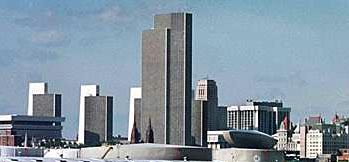 The
Albany Mall's monumentality soars to high heaven and sits on the
town with the grace of a battleship on a lily
pond. It is totally unrelated
to the city's pattern and life. Rockefeller's Cultural Center, which
will the Capital on the other end of the Mall platform, will, to
be sure, draw crowds to art shows and exhibits. There are to be
an amphitheatre
and all kinds of activities - ice skating rinks, carousels, day care
centers, refreshment stands, and whatnot – to say nothing of
the convention hall, shops and cafeterias that, along with parked
cars,
are to he stuck into the bowels of that huge platform. Harrison foresees
that guided tours of these wonders will help repay some of the Mall's
cost. But the tourists will take their money to the Mall and run.
It is a separate, isolated spectacle. There is nothing to draw them
into
town. In fact there are only limited, circuitous ways of getting
elsewhere in Albany on foot.
The
Albany Mall's monumentality soars to high heaven and sits on the
town with the grace of a battleship on a lily
pond. It is totally unrelated
to the city's pattern and life. Rockefeller's Cultural Center, which
will the Capital on the other end of the Mall platform, will, to
be sure, draw crowds to art shows and exhibits. There are to be
an amphitheatre
and all kinds of activities - ice skating rinks, carousels, day care
centers, refreshment stands, and whatnot – to say nothing of
the convention hall, shops and cafeterias that, along with parked
cars,
are to he stuck into the bowels of that huge platform. Harrison foresees
that guided tours of these wonders will help repay some of the Mall's
cost. But the tourists will take their money to the Mall and run.
It is a separate, isolated spectacle. There is nothing to draw them
into
town. In fact there are only limited, circuitous ways of getting
elsewhere in Albany on foot.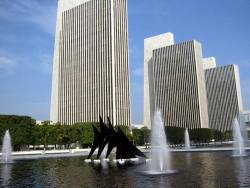 At
first the 43-story skyscraper and the parade of four, identical
23-story skyscrapelets (as Vladimir Nabokov might put it) it commands
were at least straight and sober. Too sober for the grand intoxication
it seems. Now, with scant functional …………..
60 per cent of their volume yields usable space compared to 80
to 85 per cent in most office buildings), they are double trapezoid
in plan and tapered in elevation and join the gaudy fun. Half a
jaunty grapefruit a la Brasilia (a meeting center) plays the clown
in the parade. And I'll spare you a description of the Mayan temple
structures, whose exteriors are unfortunately completed. They are,
I take it, to provide vertical contrast. Their brutal clumsiness
hardly gains by a marble veneer. The governor -who said that, in
general, he does not create architectural ideas, "I let them
come to me"-confessed to having fussed with their design.
I am glad he does not create architectural ideas.
At
first the 43-story skyscraper and the parade of four, identical
23-story skyscrapelets (as Vladimir Nabokov might put it) it commands
were at least straight and sober. Too sober for the grand intoxication
it seems. Now, with scant functional …………..
60 per cent of their volume yields usable space compared to 80
to 85 per cent in most office buildings), they are double trapezoid
in plan and tapered in elevation and join the gaudy fun. Half a
jaunty grapefruit a la Brasilia (a meeting center) plays the clown
in the parade. And I'll spare you a description of the Mayan temple
structures, whose exteriors are unfortunately completed. They are,
I take it, to provide vertical contrast. Their brutal clumsiness
hardly gains by a marble veneer. The governor -who said that, in
general, he does not create architectural ideas, "I let them
come to me"-confessed to having fussed with their design.
I am glad he does not create architectural ideas.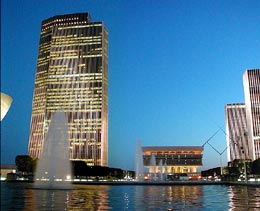 The
ignored report said that such an expression should not be merely "a
plan, but a three-dimensional urban form, merging from considerations
of social, economic, technological and esthetic factors, giving future
generations a key to our hopes and aspirations."
The
ignored report said that such an expression should not be merely "a
plan, but a three-dimensional urban form, merging from considerations
of social, economic, technological and esthetic factors, giving future
generations a key to our hopes and aspirations."